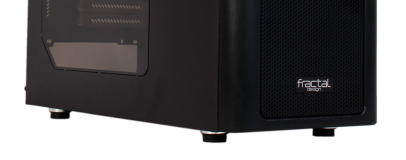
Interior
The side panels of the Fractal Design Arc Mini R2 are easy to remove thanks to their handles, although they're attached via notches and rails rather than front hinges. Unlike the iconic Define series, you won't find any noise dampening materials lining the panels, as Fractal's Arc cases are built with performance as the priority. As mentioned, the roof is easy to remove thanks to a pair of thumbscrews, while the entire plastic front fascia will also come away with a firm tug. The front fans attach directly to this panel, but thankfully the I/O panel remains in place so you won't need to pull a mess of wires out when tweaking the front cooling arrangement.The painted black interior with white drive trays and expansion brackets is classic Fractal, and comes with the company's usual exquisite attention to detail. Padding where the PSU meets the case will soften any vibrations, and there are thumbscrews on all the expansion brackets and as large a cutout on the motherboard tray as you're ever likely to need when installing a CPU cooler. All of the internal cables are sleeved in black, including those of the three fans, and there's even a USB 2.0 downgrade header on the front USB 3.0 cable for older motherboards. In short, working with the Arc Mini R2 is dead simple.
Six well placed smaller holes around the motherboard tray are filled with sturdy rubber grommets in order to aid cable management, and there are plenty of hooks and zip ties for keeping things in place. There's a healthy amount of room behind the motherboard tray, at least 15-20mm, although the right side panel is flat rather than bowed out so this is all you have to play with. Building our system, we had little issue stashing cables, but we did store a fair few of them in the empty optical drive bays.
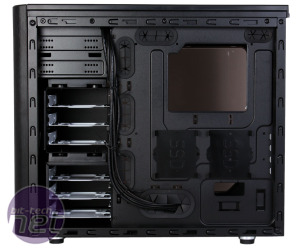
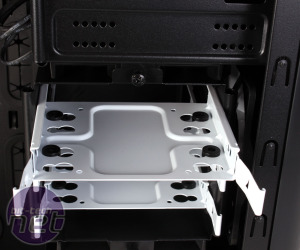
Click to enlarge - There are two SSD trays behind the motherboard (left) and six regular SSD/HDD trays (right)
Fractal again uses its sturdy metal drive sleds with the Arc Mini R2, which is no bad thing. All drives must be screwed into place regardless of their size, but there are silicone mounts and anti-vibration screws for mechanical disks. The drive trays themselves lock into their slots securely but equally are easy to remove. In addition to these six SSD/HDD bays, two more SSDs can now be screwed into dedicated trays behind the motherboard. In the Midi R2, the lack of dedicated trays meant you had to remove your motherboard just to mount and unmount SSDs here. We were quick to complain about this, and it's awesome to see Fractal taking note of this and addressing it for the Mini version of the case.
Once again, a couple of thumbscrews allow you to easily remove the top HDD cage to make way for graphics cards longer than about 260mm (we were just able to fit a stock GTX 780 Ti in, but not the GTX 690). The cage can also be rotated by 90 degrees to optimise airflow from the front fan. There's now also the option to remove both the lower and optical drive cages in order to make room for additional water-cooling. These take considerably longer to remove and install as they're both held in place by a small handful of Philips screws, but it's something you're only likely to need to do very rarely if more than once.
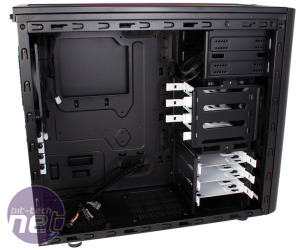
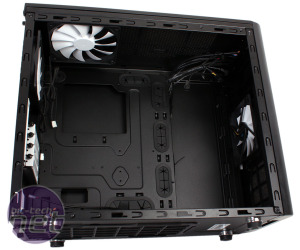
Click to enlarge - The middle drive cage can be rotated (left) but all three cages can be removed to make way for water-cooling (right)
The new water-cooling possibilities represent the biggest upgrade over the previous chassis. The additional 120mm front fan mount means the roof can now accommodate 360mm as well as 240mm radiators, although the latter requires the removal of the ODD cage. This is another fantastic addition - even this case's bigger brother, the Midi R2, couldn't house a 360mm radiator by default and required modding to do so. The offset mounts mean that unless your motherboard or memory heatsinks are unusually large, both thick and thin radiators can be used in a push-pull arrangement here as well.
Meanwhile, thanks to the removable lower drive cage, the front of the chassis can now house a 240mm radiator. Again, there's easily enough space for a push-pull configuration here using a thick radiator, although radiators taller than 275mm will also mean removing the ODD cage. The Arc Mini R2 may not be as small as other mATX cases, then, but it nonetheless has an excellent amount of water-cooling support for its size and is actually more flexible out of the box in this regard than the bigger Midi R2.

MSI MPG Velox 100R Chassis Review
October 14 2021 | 15:04

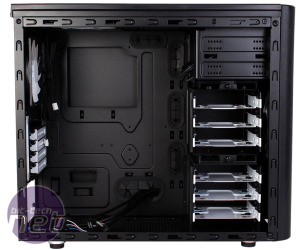
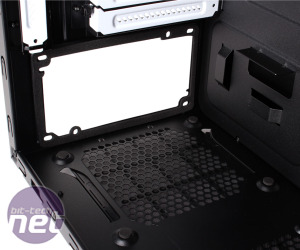







Want to comment? Please log in.